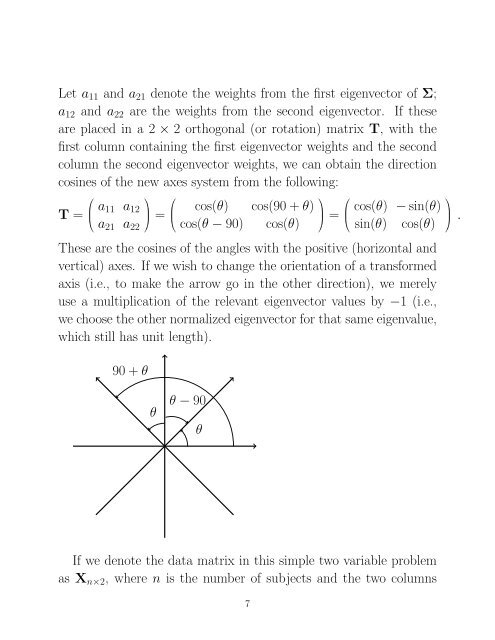Notes on Principal Component Analysis
Notes on Principal Component Analysis
Notes on Principal Component Analysis
You also want an ePaper? Increase the reach of your titles
YUMPU automatically turns print PDFs into web optimized ePapers that Google loves.
Let a 11 and a 21 denote the weights from the first eigenvector of Σ;<br />
a 12 and a 22 are the weights from the sec<strong>on</strong>d eigenvector. If these<br />
are placed in a 2 × 2 orthog<strong>on</strong>al (or rotati<strong>on</strong>) matrix T, with the<br />
first column c<strong>on</strong>taining the first eigenvector weights and the sec<strong>on</strong>d<br />
column the sec<strong>on</strong>d eigenvector weights, we can obtain the directi<strong>on</strong><br />
cosines of the new axes system from the following:<br />
T =<br />
⎛<br />
⎜<br />
⎝<br />
a 11 a 12<br />
a 21<br />
⎞ ⎛<br />
⎟ ⎜<br />
⎠ = ⎝<br />
a 22<br />
cos(θ) cos(90 + θ)<br />
cos(θ − 90) cos(θ)<br />
⎞<br />
⎟<br />
⎠ =<br />
⎛<br />
⎜<br />
⎝<br />
cos(θ) − sin(θ)<br />
sin(θ) cos(θ)<br />
These are the cosines of the angles with the positive (horiz<strong>on</strong>tal and<br />
vertical) axes. If we wish to change the orientati<strong>on</strong> of a transformed<br />
axis (i.e., to make the arrow go in the other directi<strong>on</strong>), we merely<br />
use a multiplicati<strong>on</strong> of the relevant eigenvector values by −1 (i.e.,<br />
we choose the other normalized eigenvector for that same eigenvalue,<br />
which still has unit length).<br />
90 + θ<br />
⎞<br />
⎟<br />
⎠ .<br />
θ<br />
θ − 90<br />
θ<br />
If we denote the data matrix in this simple two variable problem<br />
as X n×2 , where n is the number of subjects and the two columns<br />
7

















